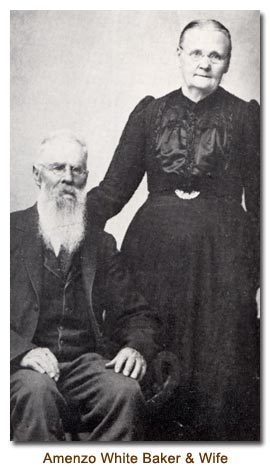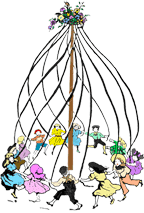Amenzo White Baker
Amenzo White Baker, son of Simon and Mercy Young Baker was born June 9 1832, at West Winfield, Herkermer County, New York.
Soon after his birth the family moved to Pomfret, Chautauqua County, New York, where the resided until 1839, when they became proselytes of the Mormon faith and moved west to Iowa, which was then a territory. At this place he attended the village school, and assisted in the labor on their new farm until the spring of 1846, when during the “exodus” of the Mormons from Illinois, he together with his parents, left their new farm and joined the fleeing camps of Mormons. They continued their march to Mt. Pisgah, Iowa, where they remained until the following August, when they moved across the river and went into Winter Quarters.
When during the winter of 1846-1847, he went with his father some 300 miles into the state of Missouri to work for provisions for their journey to the Rocky Mountains.
In May 1847, the family started on their march for the west, Mr. Baker being assigned to drive two yoke of oxen on one wagon, maintaining this position until their arrival in Salt Lake City, October 2, 1847, although he was only a boy of fifteen years. He assisted his father in getting material out of the mountains for their house and making preparations for the winter. Being short of provisions, and as there was an abundance of thistles in the bottoms about one mile south of the fort, Mr. Baker was assigned the duty of gathering thistle roots with which he supplied the family during the winter of 1847-1848. The following spring he helped his father in putting in some crops and in the fall helped him gather what he had raised, mostly corn, damaged by an early frost, necessitating an early harvest.
His father being forced to economize, determined to make the best of his misfortunes, so while the boys were cutting and stripping the blades from the corn stalks, made a wooden mill to press them, and from the juice made molasses, which proved to be a great blessing and furnished the family with sweets they would have gone without otherwise. He continued this business until the fall of 1849, attending a winter school.
In 1851 he went with his father to work in what was afterwards called Baker’s Canyon in Davis County, where he labored until the fall of 1853, when he, with his brother George W. and some fifty others, were called on a mission to the Indians. There they built Fort Supply, at what is now called Robertson, Wyoming and labored at farming and preaching to the Indians until the fall of 1856.
This year, Mr. Baker raised a good crop, and this being one of those experimental years in handcart emigration, several of the rear companies were caught in the deep, early snow in a destitute condition. This being reported to President Young, a call was made for volunteers with good teams and wagons to go to their rescue and bring them into Salt Lake City.
Mr. Baker volunteered and being 100 miles east of Salt Lake City it gave him and his comrades 100 miles the lead of those who volunteered from Salt Lake City. They traveled east until they met the rear companies, bringing them on until they met the next company, etc. Here he experienced the most heart rending scenes of his life; women and children almost naked, in snow to their knees, some with frozen feet, and almost famished with cold and hunger. Here he performed the most heroic acts of his life in helping and caring for those unfortunate beings. He seems to have had the courage of a lion to do what he did. Some one or more of those unfortunate died each night, so there was a burial every morning before breaking camp.
On one occasion they buried sixteen persons in one grave or pit. He continued his labors with those people until they arrived at Fort Bridger, when he was relieved by fresh recruits from Salt Lake City.
During his missionary work among the Indians, he had many narrow escapes with his life, some were very hostile, bet it seemed the Lord was with them and they always escaped unharmed. After being released from this mission he returned to his father’s home in Salt Lake, December 16, 1857. In 1858 he took an active part in helping to move poor families from Salt Lake City to Provo, Utah County.
The spring of 1859 found him preparing for a trip to his native state of New York to visit relatives and collect genealogy, working his way to Omaha by driving a four mule team, and returning in the fall working his way back to Salt Lake City.
The following winter he assisted in feeding cattle at his father’s ranch on the Jordon River. In the spring of 1860 he, in company with his brothers George W. and Albert M. started for Cache Valley, April 5, arriving in Mendon on April 18, 1860. During 1860-1861 he helped to build houses and corrals, also started farming. In 1861-1862, he taught the first school in Mendon, Utah. In 1863 he was called to go to Omaha to assist in bringing some Mormon Emigrants to Utah. It required five months for the round trip. He was called to make a second trip the next year, 1863, this making him a record of having driven an ox team at least 25,000 miles.
He donated all his work, also donated much work on the Logan and Salt Lake Temples and many meetinghouses.
On November 19 1864 he married Agnes Steele Hill, a widow with four small children. In later years there were born to them eight children, making a family of twelve. The remainder of his useful life was spent on his 160-acre farm on the outskirts of Mendon. He was stricken with pneumonia from which he died July 13 1907, surrounded by his children and many loving friends. Thus ended the career of a great man, a good Christian, kind husband loving father, patriotic citizen and good neighbor.
